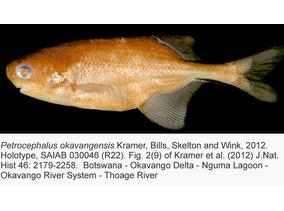Vous êtes ici
Mormyridae
Petrocephalus okavangensis Kramer, Bills, Skelton & Wink 2012
Nomenclature
-
Subfamily: PetrocephalinaeGenus: Petrocephalus
SUMMARY
Original description from Kramer et al (2012):
Body oval shape. Head with distinctly pointed nose in most specimens, with a small ventrally positioned subterminal mouth, situated ventral to the eye; head and body dorsolaterally compressed. Dorsal fin (a) origin situated about two-thirds of standard length from snout, (b) obliquely orientated, anteriorly higher and posteriorly lower, (c) distal margin crescentic with anterior two or three rays longer than posterior rays, and (d) number of rays 20 (n = 3), 21 (n = 13), 22 (n = 15), 23 (n = 8), 24 (n = 6). Anal fin (a) longer than dorsal fin, (b) opposite dorsal fin with slightly more anterior origin, (c) obliquely orientated, anteriorly lower and posteriorly higher, (d) anterior 10 or so rays longer than posterior ones, especially in males where they also appear stronger, (e) margin broadly rounded, (f) rays posterior to first 10 with distal margin straight, (g) number of rays 27 (n = 1), 28 (n = 1), 29 (n = 6), 30 (n = 21), 31 (n = 12), 32 (n = 4). Forked tail fin with rounded lobes. Scales cycloid with reticulate striae, scales extending anteriorly to operculum and pectoral fins (beyond pelvic fins). Scales in lateral series, 37 (n = 2), 38 (n = 1). Scales on caudal peduncle circumference, 12 (n = 45). Caudal peduncle slender, subcylindrical entire length, usually 20.7% (18.2–23%) of SL.
Electric organ discharge a triphasic pulse with strong head-positive phase P1 followed by head-negative main phase N, and very weak head-positive P2 phase. Pulse duration mean 574 (520–628) μs in females (n = 2); (25◦C, 2% threshold criterion).
Males with kink in anal fin base which is absent in juveniles and females where the anal fin base is straight.
Colour in life: grey-silver or brownish-silver, then with gold-olive hue, anal fin base emphasized by black line, less distinct for dorsal fin base, first few rays of unpaired fins darker, irregular shaped dark spot under dorsal fin origin, sometimes visible only on one body side, throat and belly very fair, back dark, paired fins light and transparent.
Colour in preservation: between ochre and light brown. Some preserved specimens’ dark spot below dorsal fin origin seems to have faded. Present at least in some individuals in all samples referable to P. okavangensis sp. nov., even when sampled in 1983.


